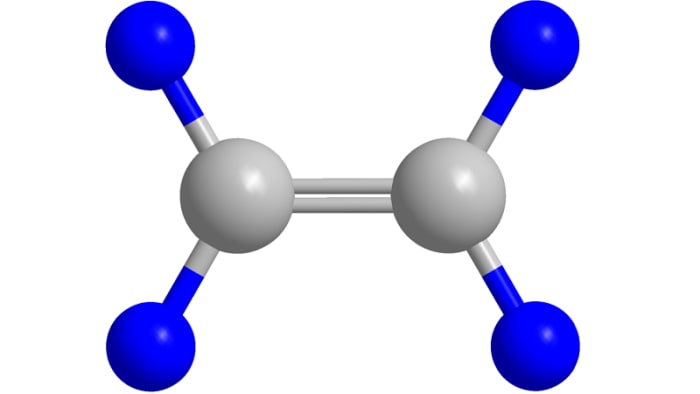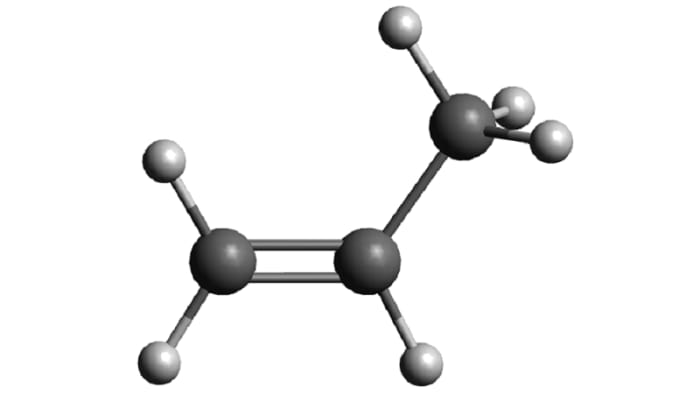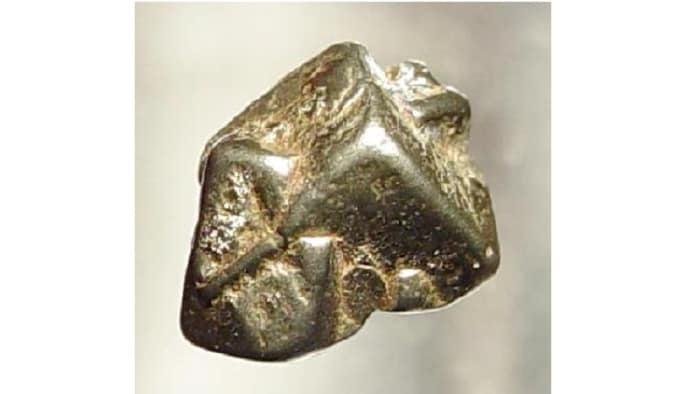Reaction of hydrogenation of alkenes
How goes hydrogenation of alkenes

Alkenes or olefins are hydrocarbons which contain a short (double) bond between carbon atoms. The general formula of alkenes is CₙH₂ₙ. As a consequence of the double bon in alkene molecules, various reactions of attachment with an opening of the double bond can be carried out. Different molecules can be attached – halogens, hydrohalogens, water, hydrogen etc. By the reaction of hydrogenation, similar saturated hydrocarbons can be obtained from alkenes – alkanes.
Features of the hydrogenation reaction
The hydrogenation of olefins (alkenes) is a reaction of the attachment of hydrogen by a double bond with the formation of alkanes – saturated aliphatic (noncyclical) hydrocarbons.
CH₂=CH₂ + H₂ = CH₃-CH₃ (with heating in the presence of Ni, ethane is formed from ethylene).

The reaction can also be accelerated by pressure. The reaction takes place in a gaseous phase with a reduction in the volume of the system (in initial reagents, ₂ volumes of gas are present – ethylene and hydrogen, and in the products only one – ethane). With a reduction of the volume of gas, pressure in the system drops, and so the reaction takes place less intensively. This property of the system obeys Le Chatelier’s principle (the equilibrium in a system shifts to the side which weakens the external impact on the system). So in these systems, increased pressure is usually created.
The reaction of the hydrogenation of alkenes is an oxidation-reduction reaction, as it is accompanied by a change in oxidation states:
CH₃-CH=CH₂ + H₂ = CH₃-CH₂-CH₃ (in propylene, in the carbon atoms from left to right the oxidation states are equal to -3, -1 and -2, and in propane - -3, -2 and -3).

Molecular hydrogen in the reaction oxidizes, acquiring an oxidation state of +1:
H₂ -2e = 2H⁺, carbon atoms with a double bond are reduced (schematically the reduction process takes place as follows):
-
C⁻¹ + e = C⁻²;
-
C⁻² + e = C⁻³.
MEL Chemistry subscription includes an experiment with hydrogen combustion.*
Depending on the catalyst used, hydrogenation may be heterogenous (if the catalyst is a metal) and homogenous (if the catalyst is a complex of a transition metal, for example rhodium or ruthenium).
Conditions of the reaction process

The reaction does not take place in normal conditions – both heating and catalysts are required. The optimum catalyst for the hydrogenation of alkenes is platinum. Owing to the high price of the metal, it is often replaced by a cheaper equivalent – nickel (catalyst – Raney nickel), in the presence of which the hydrogenation reaction also takes place. The most active catalysts of the process may be ruthenium and rhodium, but these catalysts have not received widespread use in industry.
When nickel is used as a catalyst, in the system a pressure of 5-10 atmospheres is usually created, and the temperature is raised to 50-100 ᵒC or 122-212 ᵒF. These are rather harsh conditions, as the nickel catalyst is less reactive than its equivalents.
Platinum is used in the form of Adams’ catalyst – platinum dioxide PtO₂, which when hydrogen is passed into the reactive mixture is reduced to platinum black – finely dispersed metallic platinum. When it is used, gentler conditions of hydrogenation are required – the reaction is carried out with heating up to 20-50 ᵒC or 68-122 ᵒF in alcohol or acetic acid under normal pressure.

At the end of the reaction, the solvent is evaporated, and the catalyst filtered.
What catalyst is better, heterogenous or homogenous?
Frequently, metals are used in industry as catalysts of hydrogenation. But heterogenous hydrogenation has a number of shortcomings:
-
ordinary bonds between carbon atoms can break off, as a result of which hydrocarbons form which are less branched or which have a shorter carbon chain;
-
the alkene can isomerize – form compounds of similar atomic composition, but of a different structure.
These factors cause the formation of secondary products of reaction, and therefore effect the yield and purity of the final product. This does not happen when homogenous catalysts are used.

Hydrogenation in the presence of complexes may be carried out in ordinary conditions:
CH₂=CH₂ + H₂ = CH₃-CH₃ (at a temperature of 273 Kelvin and a pressure of 1 atmosphere in the presence of Wilkinson’s catalyst, the complex of rhodium [C₆H₅P]₃RhCl – tris-(triphenylphosphane) rhodium chloride.
Heterogenous catalysts can also selectively reduce short bonds. If there are several short bonds in a compound, in the present of these catalysts only one of them can be reduced – for example, the double bond will reduce much more quickly which has fewer substitutes (mono- or di-substitution) than the one with more substitutes (tri- or tetra-substitution):
CH₂=CH-CH₂-CH=C(CH₃)₂ + H₂ = CH₃-CH₂-CH₂-CH=C(CH₃)₂ (the less substituted double bond is reduced more quickly in the presence of [C₆H₅P]₃RhCl).
the process can be used for making fuel with a high octane number.